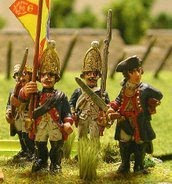 Here are two stands of Hessian converged grenadiers that I painted up about a year ago. Each stand is comprised of figures uniformed in two different facing colors, representing the mixed units that would comprise a battalion. I've kept these units fairly generic, hoping that they could serve as either Grenadier Battalion von Linsing, von Block/Lengerke, von Minnegerode or Koehler. Each stand has it's own officer so that each stand may be used independently at lower scales in V&B.
Here are two stands of Hessian converged grenadiers that I painted up about a year ago. Each stand is comprised of figures uniformed in two different facing colors, representing the mixed units that would comprise a battalion. I've kept these units fairly generic, hoping that they could serve as either Grenadier Battalion von Linsing, von Block/Lengerke, von Minnegerode or Koehler. Each stand has it's own officer so that each stand may be used independently at lower scales in V&B.The figure mix is Foundry and Front rank, with the rank-and-file being Front rank and the officers being Foundry. I'm particularly happy with the drummer figure which was a pleasure to paint with it's well-cast swallow's nests and sleve chevrons. In many of my units I'm guilty of being lazy and not taking the time to properly color my musicians, but with this figure's superb casting I took the extra time to do a nice job on this drummer. The flag for this unit is another of my home-made ink-jet printer flags. As you can see from the side-bar graphic to the right, this is one of my favorite units.






















